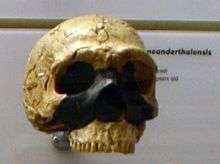Amud 1
 Amud 1 cranium cast without the mandible | |
| Catalog no. | Amud 1 |
|---|---|
| Species | Homo neanderthalensis |
| Age | 55,000 years |
| Place discovered | Amud, Israel |
| Date discovered | July 1961 |
| Discovered by | Hisashi Suzuki and others |
Amud 1 is a nearly complete but poorly preserved adult Southwest Asian Neanderthal skeleton thought to be about 55,000 years old. It was discovered at Amud in Israel by Hisashi Suzuki in July 1961, who described it as male. With an estimated height of 1.78 m (5 ft 10 in), it is considerably taller than any other known Neanderthal,[1] and its skull has by far the largest cranial capacity (1736[2]-1740[3] cm3) of any archaic hominin skull ever found,[note 1] making it, according to Ralph Holloway, one of the most famous specimens of Neanderthal skulls.[5]
The skull was found very high in the stratigraphy and was not only mixed with Upper Palaeolithic artefacts, but also with pottery from levels further above. Because of this the first two published dates of Amud 1 and other remains were not taken seriously when they suggested an extremely recent time (by Neanderthal standards) of 28,000 and 20,000 years. It has since been redated by ESR to about 55,000 years.
Like other Neanderthal specimens in the Levant (such as Tabun C1 and the Shanidar specimens), Amud 1's skull is long, broad, and low, with an especially large nose and a big face, pronounced midfacial prognathism, and a large palate and lower jaw. To the contrary of other Near Eastern Neanderthals, its brow ridges are slender and its chin, though still minimal by modern human standards, are somewhat developed. Although Amud 1 is considerably taller than any other known Neanderthal, its body is stocky, robust, and has short limbs, similarly to the cold-adapted bodies of Classic West European Neanderthals.[1]
Suzuki initially interpreted these features as intermediate between Levantine Neanderthals (the Tabun and Shanidar specimens) and Levantine anatomically modern humans (Skhul and Qafzeh).[6] In 1995, Hovers et al. argued that its cranial and mandibular particularities made it fully Neanderthal,[7] and although rejected by Belfer-Cohen (1998), this is now the accepted classification. Amud 1 is highly progressive for a Neanderthal and has many derived traits shared with early anatomically modern humans and even modern humans.[8][9]
The skeleton is currently held at Tel Aviv University, Israel.
See also
Notes
References
- 1 2 Stringer, C.; Gamble, C. (1993). In Search of the Neanderthals. London: Thames and Hudson. p. 100-101. ISBN 978-0500050705.
- ↑ Amano, H.; Kikuchi, T.; Morita, Y.; Kondo, O.; Suzuki, Hiromasa; et al. (Aug 2015). "Virtual Reconstruction of the Neanderthal Amud 1 Cranium". American Journal of Physical Anthropology. 158: 185–197. doi:10.1002/ajpa.22777.
- ↑ Ogawa, T.; Kamiya, T.; Sakai, S.; Hosokawa, H. (1970). "Some observations on the endocranial cast of the Amud man.". In Suzuki, Hisashi; Takai, F. The Amud man and his cave site. Tokyo: Keigaku Publishing. pp. 407–420.
- ↑ Vandermeersch, Bernard (1981). Les hommes fossiles de Qafzeh (Israël). Paris: Éditions du CNRS. p. 141. ISBN 978-2222028277.
- ↑ Holloway, R.L.; Broadfield, D.C.; Yuan, M.S. (2004). The human fossil record: brain endocasts: the paleoneurological evidence. Hoboken: Wiley. doi:10.1002/0471663573. ISBN 9780471663577.
- ↑ Suzuki, Hisashi; Takai, F. (1970). The Amud man and his cave site. Tokyo: Keigaku Publishing Co.
- ↑ Hovers, E.; Lavi, Y.; Kimbel, W. (1995). "Hominid remains from Amud Cave in the context of the Levantine Middle Paleolithic". Paléorient. 21 (2): 47–61.
- ↑ https://www.researchgate.net/profile/Anna_Belfer-Cohen/publication/227227451_Sapiens_and_Neandertals/links/56e7e78008ae166360e4bc13/Sapiens-and-Neandertals.pdf
- ↑ https://books.google.pl/books?id=iNdKDgAAQBAJ&pg=PA412&lpg=PA412&dq=amud+highly+progressive+neanderthal&source=bl&ots=1-vZlYs_Tl&sig=_qLBkySwF9t41yFbJ7OZAOoyO0c&hl=pl&sa=X&ved=0ahUKEwjA-bb6-fvbAhXlCcAKHR3eBxMQ6AEISjAE#v=onepage&q=amud%20highly%20progressive%20neanderthal&f=false